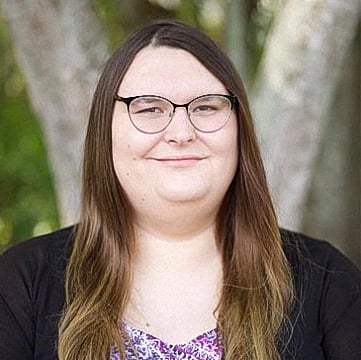
I hastily made my way into the choir room, a bit out of breath from my rush to make it on time before rehearsal began. As I fumbled with my purse, choir binder, keys, and energy drink, my phone fell out of my hands and clattered onto my desk. The home screen quickly illuminated, revealing my phone’s wallpaper, a picture of a gorgeous island escape, as well as the date. October 3rd. I sighed.
The month of October means many things to many people. For some, it represents pumpkin spice lattes, hayrides in brisk, fall air, or the return of the quintessential joy that comes from dressing up and getting free candy. As a choir director, I typically equate October with the month in which my ensembles must begin working on holiday music for the Winter season. After all, no audience enjoys a clunky rendition of “Silent Night” where said concertgoers leave wishing they had heard more silence, and less music, on said night. Starting in October was the only way to ensure that by the time early December rolled around, holiday pieces were polished and ready to perform.
The school bell rang and my Varsity Treble junior high ensemble filed in. After a quick swig of my Monster, I began welcoming the singers, ensuring to remind them to have their pencils and binders ready to go. Today was New Music Day and the excitement was palpable. I found it hard to not be excited myself; I’m a sucker for novelty and new, shiny things. I’m basically like a mermaid in that regard—albeit a much clumsier one.
Once more, the school bell sounded, signifying the start of class, our rehearsal for the day. I began to pass out the new pieces of music, bracing myself for the inevitable rebuke and loud consternation that comes from adolescents. I was particularly excited for a new choral piece I had found written by my friend, Michael John Trotta, someone I had met during my undergrad at Louisiana State University. The piece, entitled “Winter’s Cold,” was gorgeous, secular, and wintery. It was the perfect choice to break up some of the more well-known holiday pieces on the program. This piece would help make the concert that much more special.
A month and a half later, I found myself feeling a bit defeated. The piece just wasn’t coming together like I had hoped. This year’s ensemble had more pitch-matching issues than I had anticipated. My altos were really struggling to perfect some of the harmonic sections and the sopranos were navigating repeated vocal placement issues when in the upper register. We were spending most of our time chasing down technique fundamentals and accurate pitches, which left little to no time for polishing. Our Winter Concert was ultimately successful, but that piece in particular was not as polished or as stunning as I had heard it in my imagination while choosing the repertoire earlier in the year. What went wrong? After much reflection, I realized that the error was mine all along.
I firmly believe that one of the harder, if not the hardest, challenges of choral directing is the selection and programming of repertoire, particularly for ensembles whose membership is a bit more...fluid. Most of my choral directing experience comes from working with middle schoolers or junior high singers. These students, perhaps my favorite age range to teach, have voices that are constantly changing or, at the very least, are regularly on “the fritz.” Additionally, in a public school setting, I constantly was working with singers that had a vast array of musical backgrounds.
Some singers could match pitch with ease and had no problem holding down their part. Others had absolutely no singing experience whatsoever, forcibly placed in the ensemble by their school counselor to ensure they received a Fine Arts credit of some sort. On top of that, many of the singers were going through puberty, dealing with ever changing hormones, emotions, and bodies. There were multiple times when I would see a tenor on a Friday and when I saw them again on Monday, I discovered their voice had changed, and they had become a bass. Other times, a singer with a changing voice would lose access to their head voice, but have a limited chest voice, leaving them with a vocal range of 3 or 4 notes at best. It was not uncommon to have singers that were stuck “droning” or had a difficult time switching from the speaking to singing voice.
With all of these various obstacles and limitations, I had to figure out the best ways to select repertoire and program my concerts, ensuring that the music was still interesting and pleasant to listen to, but most of all, accessible for my singers. The following is a list of some of the ways I approach programming and repertoire selection for a concert to best set my ensembles up for success.
1. Determine the vocal range and musical ability of each singer.
There’s a reason this is number 1 on my list. It’s the most important consideration you have to take into account. If your sopranos top out on an F, you wouldn’t want to select a piece in which there’s a high G. If your baritones are significantly weaker at or below a C3, it would be problematic to choose a piece where they spend most of their singing time in that range. I recommend knowing the upper and lower limits of every singer’s voice, and then determining a solid average pitch range for each section.
Additionally, as the director, you need to have an idea as to the general musical capability of each singer in the ensemble. This will allow you to get a better understanding not only of the difficulty of repertoire you can choose, but also how many times you can split a section. For instance, you may have 8 sopranos that consist of a strong soprano section, but depending on the singers or the specific ranges/capabilities of those singers, singing in a S1/S2 split may be too challenging or not ideal. Knowing the ranges and capabilities of every singer is essential.

2. Identify the amount of time and number of rehearsals you have before your concerts.
Different choirs have different musical capabilities. One choir may voraciously learn music, being able to quickly learn a piece in only a couple of rehearsals. Others, particularly those whose members are not professional musicians, may take longer. That’s okay! But it does mean that you need to realistically assess how much time and how many rehearsals you will have before the performance. Consider sketching out a general timeline for learning each piece, ensuring to leave extra time for polishing, memorization, and choreography—or as I call it “choralography”—if applicable.
3. Decide on voicings and the total number of pieces for the ensemble(s) in alignment with the allotted timeframe.
Once you’ve figured out your general timeframe, determine the voicings/part arrangements you will be exploring for your ensemble. For example, if you only have 2 tenors, it may be best to select SAB rep instead of SATB. Or, if you know that your altos will have difficulty handling a 2-part split, selecting an SSAA piece with a limited timeframe may not be the optimal choice. If you only have 9 rehearsals to learn the piece, and you believe it will take more than 9 to get it to the place you want it to be, consider either starting the rehearsal of the piece earlier or save the piece for another concert when you have more time.
4. Consider an overarching theme for your concert.
Okay, I admit, this one is far from novel. However, I think that it’s always easiest to try and plan for a desired theme before picking pieces instead of selecting repertoire willy-nilly and hoping that a theme emerges from the proverbial repertoire chaos. I’ve seen many themes be successful, such as “Night and Day,” “Four Seasons,” “A Night at the Movies,” or “Through the Decades.”
Personally, I love when I see extremely creative themes that I never would have thought of. For example, the choir, Infinitus, at Jacksonville University recently performed a concert entitled “Before It’s Too Late: Things We Didn’t Have Time to Say.” Genius. The ensemble is a collective of students who jointly select the repertoire, choose themes, and rehearse music, guided by Dr. Julian Bryson. When I asked him about themes, Dr. Bryson shared that he encourages his choral students to use a middle-ground approach. He chooses a few pieces that the ensemble can do successfully, crafts a theme from what is selected, and then adds some pieces to fill the gaps.
Sometimes themes need to be more loose, or it’s needed for a concert to purposefully not have a specific theme, so that the repertoire selection can be more varied and mixed. Different choirs will have different needs, so choose what’s best for yours.
5. Select pieces that interest you as well as your singers!
I have been part of ensembles in which the director chooses a piece that it’s clear they don’t like. Those negative feelings, even if not mentioned aloud, seep into the rehearsal and make the rehearsal process of the piece that much worse. Typically, the choir never “comes around” to the piece, and everybody is more likely to be miserable. Try and make it a goal to stay up-to-date with new publications, especially from composers you love. Find pieces that spark joy for you, or at the very least are interesting to you, otherwise you will be hard-pressed to get buy-in from your singers, and ultimately your audiences.
.png?width=1920&height=1080&name=CC%20Image%20(1).png)
6. Balance the concert vibes.
Strive to balance the tempos, messages, and overall vibes in the concert. Make sure that as you are selecting pieces you don’t accidentally make all of them fast, or all of them slow. One or two slow pieces in a row is fine, but anything more than that and your audience runs the risk of falling asleep. Consider breaking up the flow of the concert by choosing pieces from different genres, or that are in different languages. If you decide to do a powerful, emotional piece, make sure it’s not preceded or proceeded by another heavy piece. Contrast will allow your audiences to stay tuned in and minimize the chance of zoning out. Also, think about how you can use different multi-sensory performance techniques to surprise the audience, which will help!
7. Study the music and consider the challenges:
Think about musical concepts or singing techniques that may be new or unfamiliar to your singers. For example, if a piece calls for singers to use vocal fry or sing in a sotto voce or straight tone style, it may take extra time to get them to be able to do that. The piece itself may have musical challenges such as tricky rhythms, cross-voicing, “unique” harmonies, tough voice leading, etc. Before you fully commit to a piece, you should be aware of every single potential challenge so that you can account for it in your planning.
8. Consider supplementing with solos, duets, or ensembles.
Your concert may need additional ways of breaking up the monotony, or “filler” acts which will enable singers to move to different positions as needed. Programming extra solo, duet, or ensemble acts to fill out the program can give some much needed breathing room for you and your singers, as well as give opportunities for singers to shine!
9. When in doubt, leave it out!
I’ve yet to meet a choir director who regrets leaving a piece that wasn’t concert-ready off of the program. Sure, the concert may have been a bit unbalanced in some capacity, or the director might have felt a little bit of guilt that their singers didn’t get to sing a piece. However, most of the time, the director is much more satisfied with a successful concert where there weren’t any hiccups or issues.
If you are getting dangerously close to concert time and a piece isn’t coming together—leave it out! Even if the programs are already made. There’s nothing wrong with announcing a brief “program change” or reprinting programs. I would much rather my audiences walk away satisfied and my singers walk away feeling successful. Quality is always better than quantity. Constantly reevaluate and reassess your programming during the rehearsal times, and if you aren’t happy with it, give yourself permission to 86 a piece. Leaving a piece out is not a failure by any stretch of the imagination. I promise, it’s okay.
10. Just because you love a piece, it doesn’t mean it’s the right fit.
As mentioned above, I absolutely LOVED the Trotta piece I chose for my Varsity Treble choir. However, I let my love and appreciation for the piece overshadow the technical challenges that should have steered me away from selecting it. Don’t let this happen to you! If you find a piece that you love, share it with a colleague (preferably one who knows your ensemble) and get their opinion on it. Chances are, that unbiased opinion will help you make the ultimate best choice for your choir.

Melanie Stapleton (she/her) is a music educator, researcher, author, and choral director located in Chicago. She is currently a PhD student at Northwestern University in Evanston, Illinois, pursuing a PhD in Music Studies with a specialization in Music Education and an interdisciplinary certificate in Gender and Sexuality Studies. She is the founder of Blurring the Binary, and holds a Masters of Music Education from the University of North Texas as well as a Bachelors of Music Education from Louisiana State University. She is a strong believer that the choral ensemble should be a musical family and a safe place offering unconditional love for all. When not teaching, she can be found hanging with her Golden Retriever, Queso, playing video games, or jamming to the latest choral hits.

